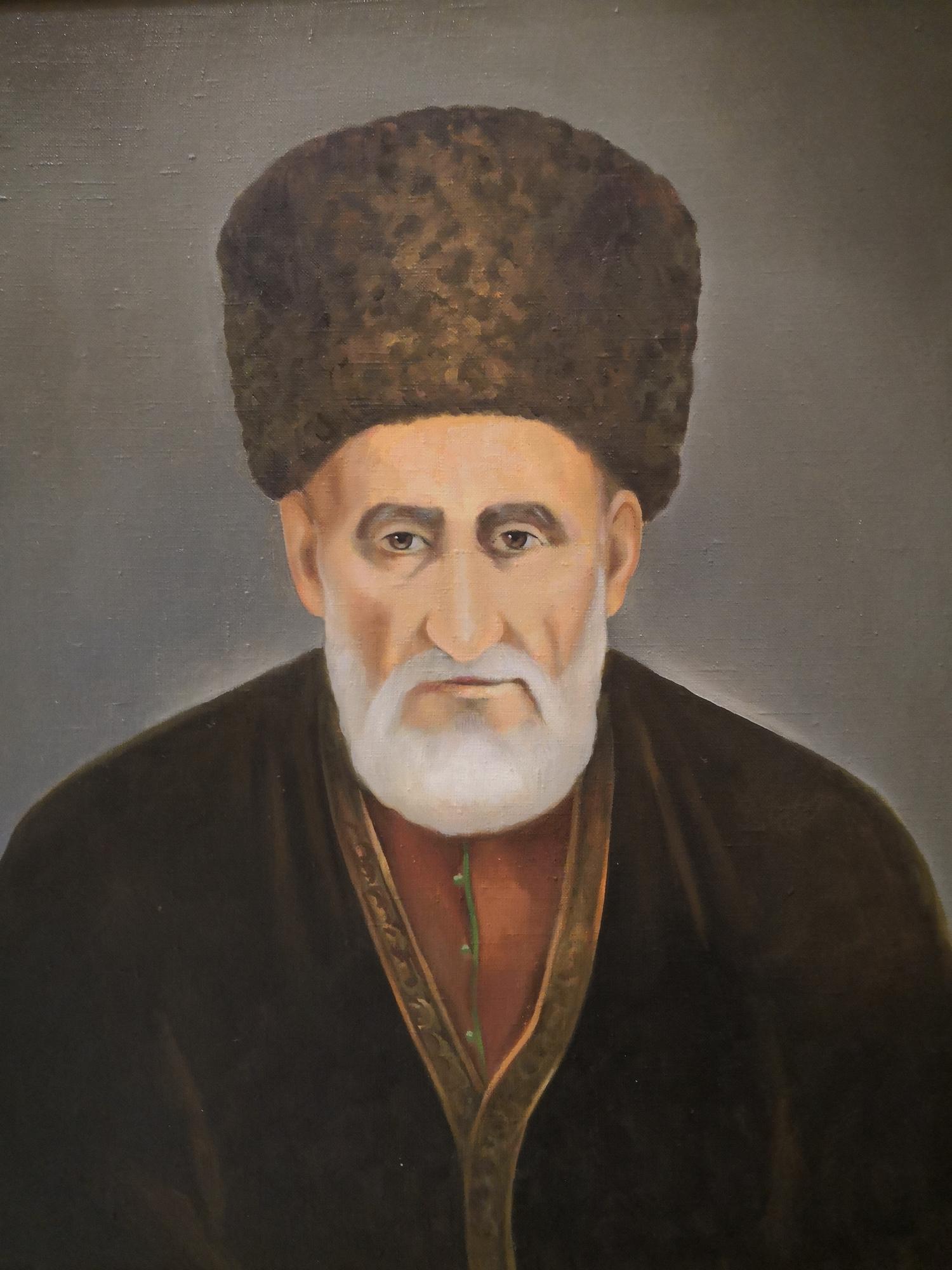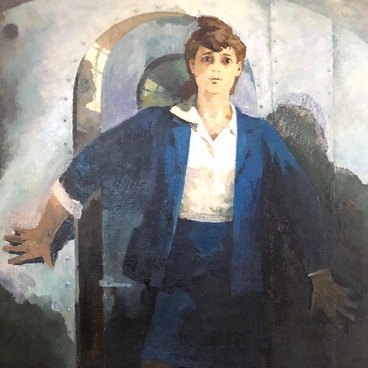Ali Saparov painted Portrait of Abdul-Vakhab-Khadzhi in oil on the canvas. He performed his work in 2008 on request of a private entity from the village of Aldy. The work was meant for a memorial structure.
Abdul-Vakhab-Khadzhi Dydymov is depicted on the picture. He was a Kumyk educator and a sheikh of Naqshbandi tariqat. Naqshbandi tariqat is a spiritual fraternity that has existed since the 14th century. He also founded an educational establishment ‘madrassa’ in Dagestan in the village of Aksai. This village is one of the largest Kumyk rural areas on the territory of Dagestan. The educator transformed it into a regional center for studying and teaching Islam and Arabic language. Owing to Dydymov, Juma mosque was restored and a bridge across the river Aksai and a central street in the village of Aksai were built. The sheikh had as many as 5000 followers-murids in Dagestan, Chechen Republic and Kabarda.
The artist painted the portrait based upon the ancient photograph. Against a grey background he portrayed a man advanced in age in the national attire. Abdul-Vakhab-Khadzhi Dydymov is dressed in a light-brown beshmet (kind of quilted jacket) and dark-brown caftan. He has papakha on his head. The face of the hero is framed by a grey beard. The lips of the man are tightly closed. The expressive hazel eyes thoughtfully stare away. The author depicted the educator in a static posture – he emphasized monumentality of his posture and calmness of the sheikh. Ali Saparov left the image without volumes in order to preserve a maximum resemblance with the photograph.
The fate of the sheikh was uneasy. In 1930 he was unfairly accused of anti-Soviet propaganda and arrested. At the age of 76 he was forced to survive through five years in imprisonment in camps. The educator was deprived of all rights and property. The man was able to stay alive and return back home. After imprisonment he settled in the Chechen Republic and earned no less respect here than in Dagestan. In 1937 he was repeatedly arrested and sentenced to 10 years of imprisonment. The old man died in imprisonment. On December 1, 1988 his name was totally whitewashed.
Ali Khamidovich Saparov is a Russian and Chechen artist. Apart from painting and graphics, he also works in ebru manner. In this technique the image needs to be created on the water surface and then transported to the paper. The artist is also known as a caricaturist and master of wood carving. Several paintings of the author are kept with the holdings of the National Museum of the Chechen Republic.
Abdul-Vakhab-Khadzhi Dydymov is depicted on the picture. He was a Kumyk educator and a sheikh of Naqshbandi tariqat. Naqshbandi tariqat is a spiritual fraternity that has existed since the 14th century. He also founded an educational establishment ‘madrassa’ in Dagestan in the village of Aksai. This village is one of the largest Kumyk rural areas on the territory of Dagestan. The educator transformed it into a regional center for studying and teaching Islam and Arabic language. Owing to Dydymov, Juma mosque was restored and a bridge across the river Aksai and a central street in the village of Aksai were built. The sheikh had as many as 5000 followers-murids in Dagestan, Chechen Republic and Kabarda.
The artist painted the portrait based upon the ancient photograph. Against a grey background he portrayed a man advanced in age in the national attire. Abdul-Vakhab-Khadzhi Dydymov is dressed in a light-brown beshmet (kind of quilted jacket) and dark-brown caftan. He has papakha on his head. The face of the hero is framed by a grey beard. The lips of the man are tightly closed. The expressive hazel eyes thoughtfully stare away. The author depicted the educator in a static posture – he emphasized monumentality of his posture and calmness of the sheikh. Ali Saparov left the image without volumes in order to preserve a maximum resemblance with the photograph.
The fate of the sheikh was uneasy. In 1930 he was unfairly accused of anti-Soviet propaganda and arrested. At the age of 76 he was forced to survive through five years in imprisonment in camps. The educator was deprived of all rights and property. The man was able to stay alive and return back home. After imprisonment he settled in the Chechen Republic and earned no less respect here than in Dagestan. In 1937 he was repeatedly arrested and sentenced to 10 years of imprisonment. The old man died in imprisonment. On December 1, 1988 his name was totally whitewashed.
Ali Khamidovich Saparov is a Russian and Chechen artist. Apart from painting and graphics, he also works in ebru manner. In this technique the image needs to be created on the water surface and then transported to the paper. The artist is also known as a caricaturist and master of wood carving. Several paintings of the author are kept with the holdings of the National Museum of the Chechen Republic.


